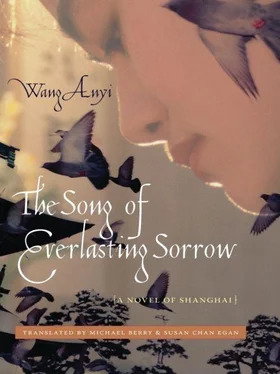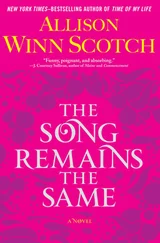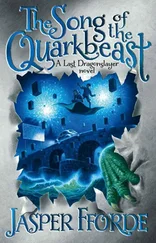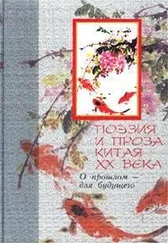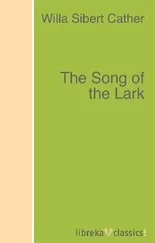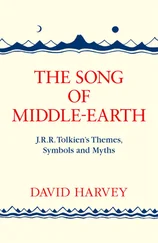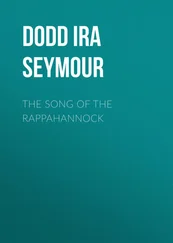Wang Anyi
The Song of Everlasting Sorrow
Translators’ Notes and Acknowledgments
THIS TRANSLATION IS based on the original version of the novel published in 1995 by the Zuojia chubanshe in Beijing. The translation is unabridged; however, there are a series of stylistic variances from the original. Chief among those are the length of paragraphs and sentences, and the presentation of direct dialogue. Long extended paragraphs and run-on sentences, both of which read fine in the Chinese original, have in many sections been broken up into shorter structures in this translation. As a challenge to herself and the reader, Wang Anyi intentionally refrained from using quotation marks and paragraph breaks to signal direct dialogue in the original, instead opting to embed dialogue directly into longer narrative sections. For the purpose of readability in English, the translators have added quotation marks and paragraph breaks in sections where direct dialogue appears (marked by the use of first-person pronouns). Other dialogue sections that use third-person pronouns have been left in their original form, embedded within longer paragraphs. Italics (which are not commonly used in Chinese text) have also been added as a stylistic device to indicate internal thought.
Thanks go first and foremost to Wang Anyi for her patience and support. The power and beauty of her literary world inspired us, and we thank her for entrusting us with this important work. David Der-wei Wang has been a staunch supporter of this translation project from its inception six years ago. We thank him for his kindness and for his willingness as series editor to include this book in the Weatherhead Books on Asia series. Thanks to Jennifer Crewe of Columbia University Press for seeing this project through. We would also like to thank the two anonymous readers, who provided valuable comments on an earlier version of the text. We appreciate the support provided by the University of California, Santa Barbara as well as the Weatherhead Foundation and the Chiang Ching-kuo Foundation, which helped make the publication of this volume possible. Special thanks go to our copy editor, Alice Cheang. We feel blessed to have had the opportunity to work with a true wordsmith, whose style, sense of literature, and encyclopedic knowledge have sharpened the literary vision of the text. The editorial support of Kerri Sullivan and Leslie Kriesel has also been extremely helpful. Finally, we thank Ron Egan, Suk-Young Kim, and our families for their forbearance and accommodation during the long period we were immersed in this project.
— M. B. and S. C. E.
LOOKED DOWN UPON from the highest point in the city, Shanghai’s longtang —her vast neighborhoods inside enclosed alleys — are a magnificent sight. The longtang are the backdrop of this city. Streets and buildings emerge around them in a series of dots and lines, like the subtle brushstrokes that bring life to the empty expanses of white paper in a traditional Chinese landscape painting. As day turns into night and the city lights up, these dots and lines begin to glimmer. However, underneath the glitter lies an immense blanket of darkness — these are the longtang of Shanghai.
The darkness looks almost to be a series of furious waves that threaten to wash away the glowing dots and lines. It has volume, whereas all those lines and dots float on the surface — they are there only to differentiate the areas of this dark mass, like punctuation marks whose job it is to break up an essay into sentences and paragraphs. The darkness is like an abyss — even a mountain falling in would be swallowed whole and sink silently to the bottom. Countless reefs lurk beneath this swelling ocean of darkness, where one false move could capsize a ship. The darkness buoys up Shanghai’s handful of illuminated lines and dots, supporting them decade after decade. Against this decades-old backdrop of darkness, the Paris of the Orient unfolds her splendor.
Today, everything looks worn out, exposing bit by bit what lies underneath. One strand at a time, the first rays of the morning sun shine through just as, one by one, the city lights go out. Everything begins from a cover of light fog, through which a horizontal ray of light crafts an outline as if drawing it out with a fine brush. First to appear are the dormer windows protruding from the rooftop tingzijian of those traditional longtang buildings, showing themselves off with a certain self-conscious delicacy; the wooden shutters are carefully delineated, the handmade rooftop tiles are arranged with precision, even the potted roses on the windowsills have been cared for painstakingly.
Next to emerge are the balconies; here articles of clothing hung out to dry the night before cling motionless like a scene out of a painting. The cement on the balustrade peels away to reveal the rusty red bricks beneath — this too looks as if painted in a picture, each brushstroke appearing clear and distinct. After that come the cracked gable walls, lined with traces of green moss that look cold and clammy to the touch. The first rays of light shining on the gable walls create a stunning picture, a gorgeous portrait, bearing just a hint of desolation, fresh and new yet not without a past.
At this moment the cement pavement of the longtang is still enveloped in fog, which lingers thick in the back alleys. But on the iron-railed balconies of the newer longtang apartments the sunlight is already striking the glass panes on the French doors, which refract the light. This stroke is a relatively sharp one, and seems to pull back the curtain that separates day from night. The sunlight finally drives away the fog, washing everything in its path with a palette of strong color. The moss turns out to be not green but a dark raven hue, the wooden window frames start to blacken, and the iron railing on the balcony becomes a rusted yellow. One can see blades of green grass growing from between the cracks in the gables, and the white pigeons turn gray as they soar up into the sky.
Shanghai’s longtang come in many different forms, each with colors and sounds of its own. Unable to decide on any one appearance, they remain fickle, sometimes looking like this, sometimes looking like that. Actually, despite their constant fluctuations, they always remain the same — the shape may shift but the spirit is unchanged. Back and forth they go, but in the end it’s the same old story, like an army of a thousand united by a single goal. Those longtang that have entryways with stone gates emanate an aura of power. They have inherited the style of Shanghai’s glorious old mansions. Sporting the facade of an official residence, they make it a point to have a grandiose entrance and high surrounding walls. But, upon entering, one discovers that the courtyard is modest and the reception area narrow — two or three steps and you are already at the wooden staircase across the room. The staircase is not curved, but leads straight up into the bedroom, where a window overlooking the street hints at romantic ardor.
The trendy longtang neighborhoods in the eastern district of Shanghai have done away with such haughty airs. They greet you with low wrought-iron gates of floral design. For them a small window overlooking a side street is not enough; they all have to have walk-out balconies, the better to enjoy the street scenery. Fragrant oleanders reach out over the courtyard walls, as if no longer able to contain their springtime passion. Deep down, however, those inside still have their guard up: the back doors are bolted shut with spring locks of German manufacture, the windows on the ground floor all have steel bars, the low front gates of wrought iron are crowned with ornamented spikes, and walls protect the courtyard on all sides. One may enter at will, but escape seems virtually impossible.
Читать дальше
